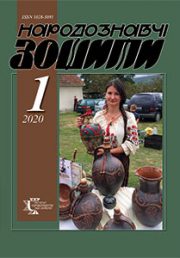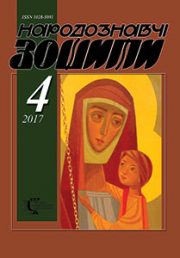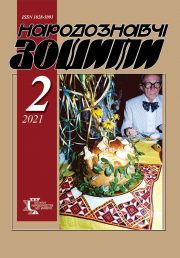The Ethnology Notebooks. 2023. № 6 (174), 1374—1385
UDK 7.025.4:27-312.47-526.62″1696″
DOI https://doi.org/10.15407/nz2023.06.1374
POCHEKVA Andrii
- ORCID ID: https://orcid.org/0009-0000-4213-4873
- Artist-restorer, Teacher of the department of Restoration Works of Art
- of the Lviv Professional College of Decorative
- and Applied Arts named after I. Trush,
- 4 Snopkivska str., 79011, Lviv, Ukraine,
- Contacts: e-mail: pochekva@gmail.com
MELNYK Iryna
- ORCID ID: https://orcid.org/0009-0000-4213-4873
- Artist restorer of the Lviv National Museum
- named after Andrey Sheptytskyi,
- 20, Svobody Avenue, 79000, Lviv, Ukraine,
- Contacts: e-mail: i-mel@ukr.net
Abstract. Given the specifics of his practical activity, the artist-restorer of easel painting quite often meets with artworks that have undergone numerous transformations, both formal and aesthetic, over time. Artworks of easel painting changed very often — they were repainted due to an unsatisfactory state of preservation, sometimes due to a change in the preferences and tastes of artists or their owners, a change in the requirements of time or the functions that these works originally performed. In an effort to discover an authentic, older painting, the restorer removes the record, which unwittingly involves the complete destruction of one of the works, which also carries information about the contemporary era, culture, and often also has both historical and artistic value. That is why the application of the process of separation and transfer of easel painting to a new base is an alternative method of solving the problem. In the study, the authors aim to: described the complex of restoration measures that preserve and at the same time open for study all the painting layers of the artwork; to analyze the problems that may arise during the application of the technique of separation and transfer to a new basis of easel painting as one of the most dangerous, most difficult and least predictable restoration measures. The object of the study is the process of separation of easel painting, as a complex of scientific, laboratory-technical and physical-chemical studies of the work of art and a number of special restoration measures and operations aimed at preserving all chronological painting layers. The subject is the analysis, substantiation and practical application of the process of separation of easel painting on the example of the 1696 icon « The Mother of God Odigitria» from the Univ Holy Dormition Lavra from the collection of the National Museum in Lviv.
The methodological basis of the research is the application of general scientific methods of theoretical and empirical research in combination with narrowly specialized historical-comparative and technical-technological methods and special physico-chemical and restoration research methods.
Keywords: separation of easel painting, painting, icon, art, work, research, conservation, restoration, conservation, paint layer.
Received 6.11.2023
REFERENCES
- Lempart-Geratowska, M. (1992). Transferring two painting layers from feretron from Wielgich with an attempt to place one of them on a new substrate. BmiOZ (Vol. LXXXVIII, series B, pp. 239—246). Warsawa [in Polish].
- Lempart-Geratowska, M. (2002). Separation of easel paintings on a wooden base. Methods and means of action. Studies and materials saw the conservation and restoration of works of art at the Academy of Fine Arts in Krakow (Vol. XI). Krakow: Academy of Fine Arts in Krakow [in Polish].
- Lempart-Geratowska, M. (2007). Separation of easel paintings — possibilities and limitations. Studies and materials saw the conservation and restoration of works of art at the Academy of Fine Arts in Krakow (Vol. XVI, pp. 63—68). Krakow: Academy of Fine Arts in Krakow [in Polish].
- Rydzewska, A., & Lempart-Geratowska, M. (2007). Separation using the «dry» method of two contemporary paintings on canvas. Studies and materials saw the conservation and restoration of works of art at the Academy of Fine Arts in Krakow (Vol. XVI, pp. 151—155). Krakow: Academy of Fine Arts in Krakow [in Polish].
- Sekowska, A. (2007). Separation of easel paintings using the shrinkage of the facing glue (the so-called «dry» method). Studies and materials saw the conservation and restoration of works of art at the Academy of Fine Arts in Krakow (Vol. XVI, pp. 133—138). Krakow: Academy of Fine Arts in Krakow [in Polish].
- Bilecki, T., & Kamykowski, J. (1978). Removing oil overpaints from tempera paintings and placing them on a new surface. Protection of monuments, 3 (122), 182—190 [in Polish].
- Kamykowski, J. (2007). Separation of easel paintings using a chemical method, developed in 1976, in the light of thirty years of achievements and experience in this field. Studies and materials saw the conservation and restoration of works of art at the Academy of Fine Arts in Krakow (Vol. XVI, pp. 79—93). Krakow: Academy of Fine Arts in Krakow [in Polish].
- Puzon, M. (2013). Separation of two paintings depicting Saint. Sebastian in a painting from the church of St. Wojciech in Krosno, currently in the collection of the Archdiocesan Museum in Przemyslu. Scholarships and materials of the scientific conference of students of conservation and restoration of works of art. Krakow, April 12—13 (Vol. II, pp. 263—275). Krakow: Publishing House of the Academy of Fine Arts. Jan Matejko in Krakow [in Polish].
- Margaritoff, T. (1987). Removing Successive Layers of Painting. Further Work in: Bromelle, N., & Smith, P. Conservation and Restoration of Pictoral Art, Butterworths (Pp. 140—145). London.
- Mokriy, V.P. (1997). Saved treasures: Catalog of the exhibition [in Ukrainian]
- Radomska, V.R. (2005). Separation of painting as a method of preserving monuments. Problems of preservation, conservation, restoration and examination of museum monuments: theses add. V International scientific-practical conf. May 24—27 (Pp. 247—250). Kyiv [in Ukrainian].
- Radomska, W. (2007). The issue of stratification of objects of easel painting, belonging to the sacred art of Galicia, on the example of the icon «The Entombment», the end of the 17th century, from the collection of the Museum — Castle in Јaсcut. Studies and materials saw the conservation and restoration of works of art at the Academy of Fine Arts in Krakow (Vol. XVI, pp. 109—116). Krakow: Academy of Fine Arts in Krakow [in Polish].
- Ivaniv, B., & Pochekva, A. (2001). The relevance of the method of separation the redrawing in tempera, oil painting (icon «Archangel Michael» from the church of the village of Semenivka). Problems of preservation, conservation, restoration and examination of museum monuments: theses add. III International scientific-practical Conf., May 22—24 (Pp. 50—52).Kyiv [in Ukrainian].
- Pochekva, A. (2022). Restoration terms used in the field of layering of easel painting and its transfer to a new base. Herald of LNAM, 48, 88—98 [in Ukrainian].
- Melnyk, I., & Pochekva, A. (2013). Research and specifics of the process of separation and transfer to a new basis of the icon «Virgin with Child» of 1696 from the Holy Dormition Univ Lavra. Preservation and research of historical and cultural heritage in museum collections: historical, art and museological aspects of activity: Reports and announcements of the International Scientific Conference. September 25—27 (Pp. 704—709). Lviv [in Ukrainian]
- Pochekva, A.I., & Yushchuk, T.A. (2016). Separation and transfer to a new basis of oil painting of the icon «Introduction to the Church of the Blessed Virgin» of the second half of the XIX century from the surface of the author’s tempera painting «St. Onuphrius the Hermit «of the end of the XVII century. Research, conservation, restoration of movable monuments of history and culture: traditions, innovations. Scientific reports X international. scientific and practical conference, May 24—7 (Pp. 282—286). Kyiv [in Ukrainian].
- Doluda, A.O., & Terekhov, M.O. (2018). Study of layering of different time paintings. Scientific restoration. History, modernity, ways of modernization. Scientific reports of the 11th international academic-practical conference, September 11—14 (Pp. 165—170). Kyiv: National Research and Restoration Center of Ukraine [in Ukrainian].
- Terekhov, M.O. (2016). Study of the process of stratification of different time paintings based on the experience of restoration of the icon «St. Nicholas» of the end of the 18th century. Research, conservation, restoration of movable monuments of history and culture: traditions, innovations. Scientific reports of the X international academic-practical conference, May 24—27 (Pp. 329—332). Kyiv [in Ukrainian].
- Doluda, A., & Terekhov, M. (2018). Experience of separation of multi-temporal painting. All-Ukrainian scientific conference of the faculty and students of KhDADM based on the results of the 2017/2018 academic year. Collection of articles. May 25 (Pp. 17—20).
- Antonenkova, N.O. (2016). Separation of different-time painting with a separating layer of varnish. Current issues of art history: the challenges of the XXI century: Coll. Articles International. scientific-practical conf. dedicated to the 95th anniversary of the Kharkiv Higher Art School (Pp. 9—12). Kharkiv [in Ukrainian].
- Dmytrokh, S. (Ed). (2008). In the collection of the National Museum in Lviv named after Andrei Sheptytskyi. Ukrainian sacred art from the «Studio» collection. (Part II). Lviv: Silver Word [in Ukrainian].
- Melnyk, I. (2014). Passport of the restoration of the monument of history and culture (movable) National Museum in Lviv named after Andrey Sheptytskyi, artist and restorer [in Ukrainian].
- Helytovych, M. Ukrainian icons of the end of the 15th and beginning of the 20th centuries. From the «Studion» collection in the collection of the Andrey Sheptytskyi National Museum in Lviv. Retrieved from: https://doi.org/10.37222/2524-0315-2020-12(28)-11; https://www.lsl.lviv.ua/index.php/uk/fahovi-vydannya/zapysky-lnnbu-im-v-stefanyka/zp2020/zb2020gelytovych_m/ (Access date 10/6/2023) [in Ukrainian].







